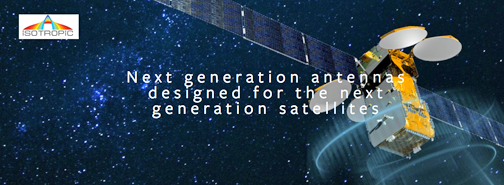
Developing spectrally efficient, low-profile antennas that are conformal, multi-band and electronically steerable is Isotropic Systems, who have just secured an additional $5 million in venture capital to further develop their satellite antenna technology for mobile and HTS applications, moving the company a step closer to bringing their innovative design to market.
Isotropic’s technology breakthrough will allow manufacturing of satellite antennas that have no moving parts and can connect simultaneously to different satellites using different bandwidths. The antenna can be shaped to almost any form factor, giving it an exceptionally low footprint. The antennas will be designed for high-capacity bandwidth applications, making them suitable for a range of mobility customers including maritime, aeronautical, enterprise, military and the nascent connected-car market.
The company also announced that it has established an operational headquarters in the Tysons commercial complex of Northern Virginia and has opened a research and testing lab in Pennsylvania.
The Isotropic antenna is designed to use the Ku-, Ka- and V- frequency bands of HTS being adopted by existing and emerging HTS operators investing in next-generation broadband or mobility service platforms, such as Inmarsat GX, O3b, OneWeb, Intelsat EpicNG, ViaSat, Boeing, and SpaceX, along with standard geosynchronous satellite operators offering mobility services.
Phased array and all other variants of flat-panel antennas being developed for HTS connectivity have materials on their surfaces that disperse radio waves in ways that lead to bandwidth inefficiency. These antennas are very complex to manufacture with costs increasing in line with the number of cross-connected circuit arrays, known as “feeds,” on the antenna surface, often impeding the overall cost and scalability. These characteristics significantly limit satellite mobility applications to the high-end, low volume market sector and fall short in ability to fully exploit the global opportunity for high-throughput services.
In contrast, the Isotropic breakthrough technology decouples the number of elements from the antenna’s scanning performance and embeds an arrangement of thin super-element devices to manipulate radio waves into a highly capable beam-forming device. This allows a design that requires about 75 percent fewer component parts overall, thus lowering manufacturing cost without loss of spectral efficiency.
Waterlow Management, a London-based venture capital firm, led the investors providing the new round of funding.
“With this funding, we will move into development of our proof-of-concept prototype for our antenna technology,” said John Finney, President & CEO of Isotropic. “Our industry is going to change dramatically over the next few years with the launch of new high-throughput and non-geostationary satellite systems. The vast opportunity to satisfy large swathes of existing and new demand for satellite data, mobility and broadband services requires the price of mobile tracking antennas to be one tenth that of existing systems. Our design targets meeting that price point and the strategic enablement of the new wave of satellite businesses cases from any orbit or frequency.”

